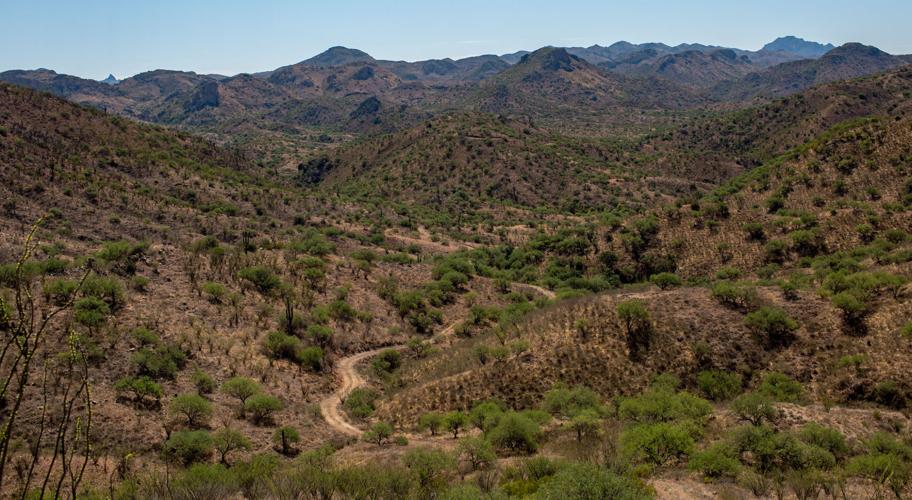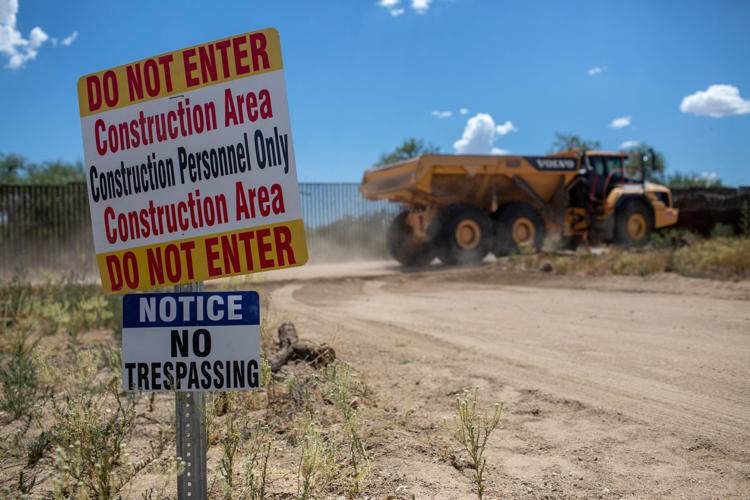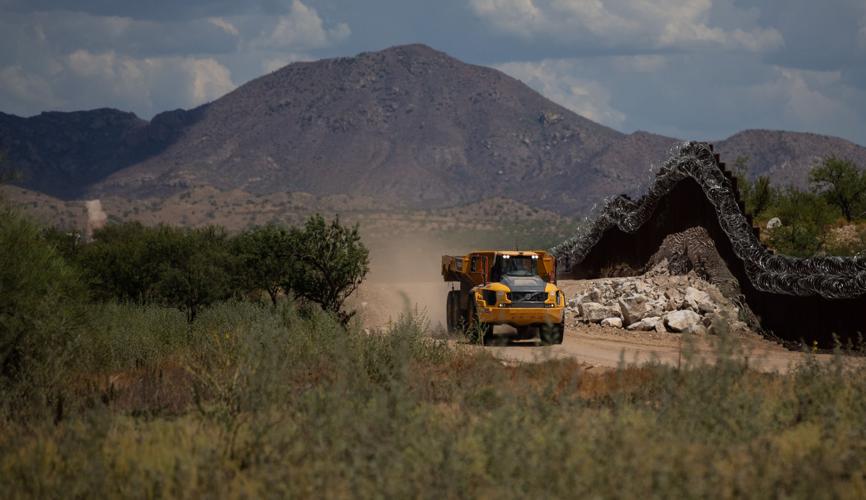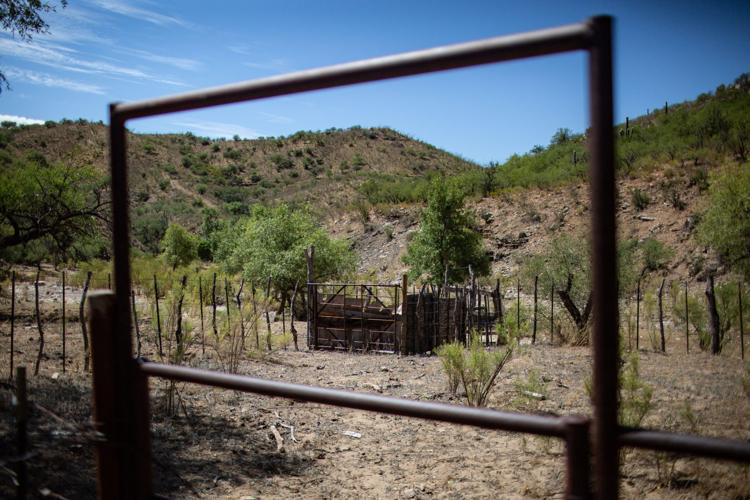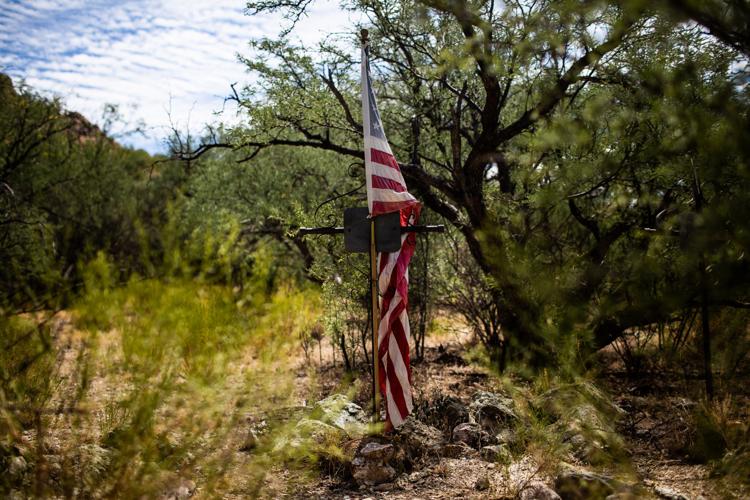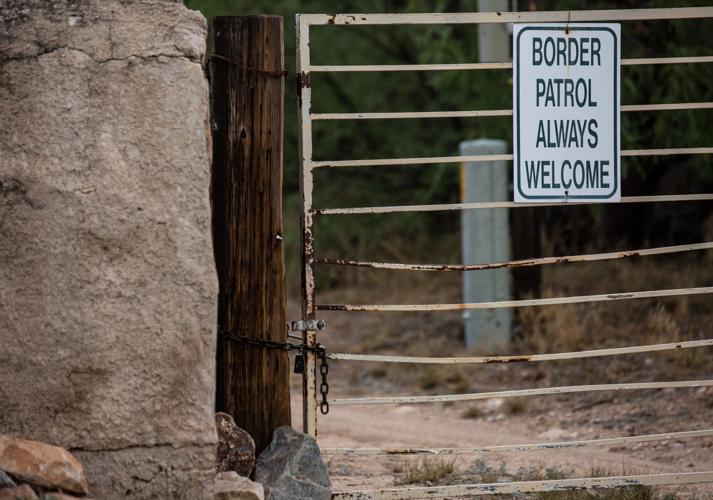The contractor building the border wall in Southern Arizona’s toughest terrain is facing accusations of shoddy work in Texas, adding questions about the company’s competency on top of an ongoing probe into whether it received building contracts after an improper push by President Trump.
Fisher Sand and Gravel started building the 30-foot-tall border wall earlier this month near Sasabe, a small border town about 70 miles southwest of Tucson. Over the next two years, the wall will cut across mountains, steep ravines and washes for nearly 40 miles to Nogales.
It is expected to cost taxpayers about $1.3 billion.
The terrain along this stretch of Arizona’s border with Sonora is far more challenging than other border wall projects in the state, most of which have taken place on relatively flat terrain.
The wall projects in Arizona include steel poles, known as bollards, topped with anti-climbing plates. Ground sensors and lighting will be added at a later date. The 6-inch wide bollards are filled with concrete and separated from each other by 4 inches of space, which allows Border Patrol agents to see activity on the Mexico side of the border. Federal officials plan to build 137 miles of wall near Tucson at a cost of more than $3 billion. So far, about 50 miles of new wall have been built, mostly to replace bollard fencing 15- to 18-feet tall or head-high vehicle barriers.
Firm’s Texas wall is called “slapdash”
While construction crews build the wall near Sasabe, federal officials in Texas are conducting an engineering inspection of 3 miles of wall Fisher Sand and Gravel built along the Rio Grande. Portions of the wall’s foundation are showing signs of erosion and the wall could be in danger of falling into the river, just months after it was built, ProPublica and the Texas Tribune reported in early July.
That revelation touched off condemnations from federal officials, including President Trump. It also raised questions about Fisher Sand and Gravel’s ability to build the border wall, which the company’s owner dismissed by saying the wall on the Rio Grande “will stand for 150 years.”
In response to the news about the wall’s foundation eroding, Trump tweeted last week he “disagreed with doing this very small (tiny) section of wall, in a tricky area” and the project “was only done to make me look bad.”
In a series of tweets, Ryan Patrick, the Trump-appointed U.S. attorney for the Southern District of Texas who is overseeing a lawsuit against Fisher Sand and Gravel over the wall on the Rio Grande, called the project “slapdash” and said the contractor “didn’t do any engineering beyond a PowerPoint slide.”
The term “slapdash” also was used by Melissa Owen to describe the Fisher Sand and Gravel wall project that sprang up suddenly a few miles south of her house in Sasabe.
Owen said “nobody wants a secure border more than I do” and welcomes Border Patrol agents on her 640-acre property. She described the wall project as a “slapdash, knee-jerk, nonsolution” that didn’t take into account the enormous improvements in border security achieved by agents and the existing 15-foot-tall fence.

Melissa Owen described the border wall project going up just a few miles south of her house in Sasabe as a “slapdash, knee-jerk, nonsolution.”
Owen said she first learned about the rough outline of the wall project near Sasabe in mid-June. Since then, she tried to get more specific answers from Customs and Border Protection officials, resulting in a meeting with several CBP officials at her house on Thursday.
After the meeting, she told the Star she was angry the officials were “put in the position to cover up for their higher-ups and the highest up.”
Tommy Fisher, the head of Fisher Sand and Gravel, which is based in North Dakota and has offices in Tempe, told the Star he had an agreement with federal officials not to comment on his company’s border wall contracts in Arizona. The Texas project was privately funded and not part of a government contract.
The worry that the wall by the Rio Grande could crumble from erosion damage is “complete nonsense,” Fisher told the Star.
The erosion is “cosmetic” and caused by grass not taking root along one-fifth of the wall. His company fixed the problem and now “everything is in great shape,” he said.
Engineers and hydrologists told ProPublica and the Texas Tribune the wall never should have been built so close to the Rio Grande and when the river rises it will further weaken the wall’s foundation.
The privately funded wall project in Texas may have left a bad taste in the president’s mouth, but those projects were some of the tools Fisher used to court the president and other federal officials as he sought border wall contracts in recent years.
Trump “got some misinformation”
Fisher led what his company newsletter called a “whirlwind media campaign” to tout its wall-building capabilities on conservative news outlets favored by Trump.
Fisher’s company also paid lobbyists $145,000 to discuss the border wall with lawmakers and invited federal officials to a privately funded wall project near El Paso and a prototype wall in Coolidge.
Trump repeatedly pushed Army Corps of Engineers officials to award wall contracts to Fisher’s company, despite the agency initially rejecting the company’s design, the Washington Post reported. When Trump recently told advisers he wanted the border wall painted black, he directed them to consult with Fisher.
In December, the agency awarded a contract worth up to $400 million to Fisher Sand and Gravel to build 31 miles of wall on the Cabeza Prieta National Wildlife Refuge southwest of Tucson. Soon after, members of Congress alleged the contract award was the result of improper influence by Trump.
The inspector general of the Defense Department opened a probe into whether the contract award followed federal the law. That probe is ongoing.
When asked by the Star whether his media campaign had an effect on his company being awarded wall contracts, Fisher said “absolutely zero, no.” Instead, he said, his company put forth the lowest-priced acceptable bids, which a Corps spokesman also has told the Star in the past.
After Trump’s tweet last week, Fisher said he thought the president “just got some misinformation on this stuff” and he still had “complete respect” for Trump, the Associated Press reported.
Nogales, Sasabe walls to be finished in 2022
In light of the erosion on the Texas border wall, the Star asked CBP and the Corps whether they were taking steps to ensure similar problems do not arise with Fisher’s design for the numerous washes that run across the border between Nogales and Sasabe.
Contractors are required to build new border wall projects according to the Border Patrol’s design standards, Matthew Dyman, a spokesman for CBP, said in a statement.
CBP and the Corps conduct a hydraulic and hydrology analysis for “all new border wall system projects in flood plains and when the barrier crosses rivers, creeks, or ephemeral transboundary water ways,” Dyman said.
The agencies did not respond to a question about whether taxpayers would cover any extra costs if erosion problems arise. In response to a similar inquiry from the Star about the risky decision to start wall construction across the San Pedro River bed in Cochise County at the start of monsoon season, a Corps spokesman said “generally” a contractor’s insurance covers those costs.
The wall project between Nogales and Sasabe is scheduled to be completed in 2022, according to Dyman.

The wall project between Nogales and Sasabe is scheduled to be completed in 2022, according to a CBP spokesman.
A “massive eyesore 100 feet wide”
As construction crews worked on the wall near Sasabe on Thursday, mountain ranges loomed in their path. They are working on mostly flat terrain with wide, graded dirt roads nearby. In the coming months, they will have to navigate a spiderweb of narrow, dirt roads among the mountains, hills, cliffs and ravines south of Arivaca that often require four-wheel drive to get over long stretches of loose rock on hillsides.
For now, the border barrier south of Arivaca is made of barbed wire or head-high steel beams designed to stop smugglers from driving across the border in remote areas. A person can easily walk through those barriers.
Large federal construction projects normally require an environmental impact assessment, but the Trump administration waived numerous laws to speed up wall construction. Local Border Patrol officials promised last fall to publish an environmental stewardship plan, but they have not published it yet.

Barbed-wire fencing along the U.S. — Mexico border south of Arivaca on July 16, 2020.
In the meantime, Arivaca residents are left wondering what is going to happen to the land they cherish and whether contractors understand the challenges of building in the area.
Standing a stone’s throw from the international border on Thursday, Arivaca residents Eli Buchanan, his father Ken and Julie Rucker talked about their concerns with the wall.

Arivaca resident Ken Buchanan lights a cigarette while taking a break from driving along the dirt roads lining the U.S. — Mexico border south of Arivaca, on July 16, 2020.
Was the contractor aware the area was riddled with mines and caves, which could be dangerous as the contractor digs foundations or uses explosives to make way for the wall, which a different contractor did a few months ago on the Organ Pipe Cactus National Monument?
What will happen when the boulders and trees that often are swept down nearby washes during heavy rains smash against the border wall? Is the Border Patrol going to repair walls in dozens of washes every year?
Would the water pumped to mix concrete for the wall impact their wells, or cut off the water that makes its way to Arivaca and eventually to farms in Marana?
Eli Buchanan worried the wall, and the massive amount of vegetation cleared to build it, would create a “massive eyesore 100 feet wide” that could ruin the views they enjoy, including on the “Sunday Funday” outings they organized prior to the pandemic.
They also worried the wall would block wildlife like pumas, deer, bears, jaguars, javelinas and antelope from being able to move through the area.
Ken Buchanan, who has lived in Arivaca since the 1980s, brought up a concern that went beyond the practical.
“There’s a spirit to this land,” he said, describing the rugged landscape as “Mother Nature without makeup on.”
“And they’re just (expletive) with it for no other reason than their fear,” he said.
Rucker grew up below a nearby mesa. Every day as a child, she was told to take in the view of the mesa as it turned red at sunset and pray to the land for what she needed in life.
“Believing you’re connected to something is important for a lot of people,” Rucker said.
“49 miles completed. 88 miles to go”
On Thursday evening, a group of about 20 Arivaca residents held a meeting outside the old schoolhouse to discuss the border wall. They plan to deliver a petition demanding the immediate halt of border wall construction to county, state and federal officials.
Among their concerns are that border wall workers could spread the coronavirus, as has happened in Ajo, according to the petition.
They called the funds for the wall a “shocking waste of resources during a time of massive need for health care and social services.”
They also are concerned the wall would push migrants fleeing violence and seeking family reunification into “dangerously remote desert crossings,” according to the petition.
While local residents search for answers about the wall, the inspector general of the Department of Homeland Security released a report on July 14 criticizing CBP’s process for deciding where to build sections of wall.
The inspector general also said CBP did not use a sound methodology to determine whether measures other than a wall would be more effective in certain areas.
In response, CBP officials said they were following a January 2017 executive order from Trump that explicitly called for the immediate construction of a border wall.
Tucson Sector Chief Roy Villareal tweeted a video on July 14 of recent construction of the border wall near Sasabe, writing “49 miles completed. 88 miles to go.”

Monsoon rain falls on mountains between Sasabe and Arivaca, Ariz., on July 16, 2020.

Melissa Owen described the border wall project going up just a few miles south of her house in Sasabe as a “slapdash, knee-jerk, nonsolution.”

Of 137 miles of border wall projects near Tucson, about 50 miles have been built, The total cost is nearly $3 billion.

A fading American Flag stands overtop a grave marker for a Buffalo Soldier south of Arivaca, on July 16, 2020.

A sign on the gate of a ranch in Sasabe welcomes U.S. Border Patrol agents.


